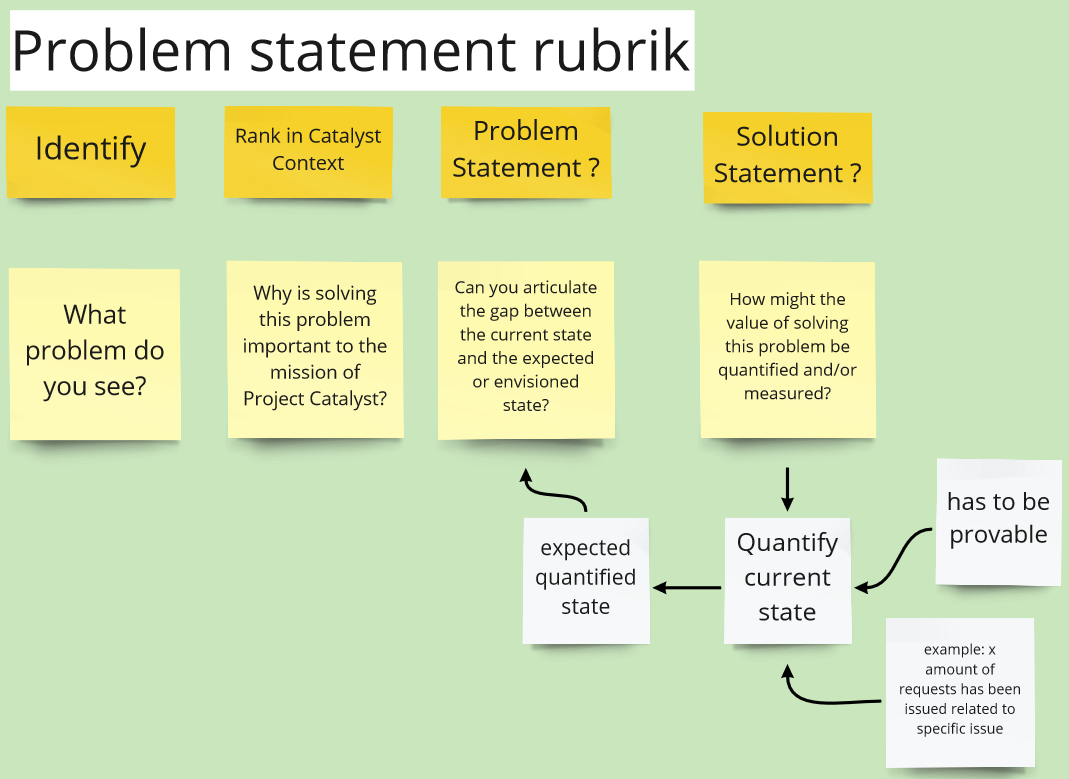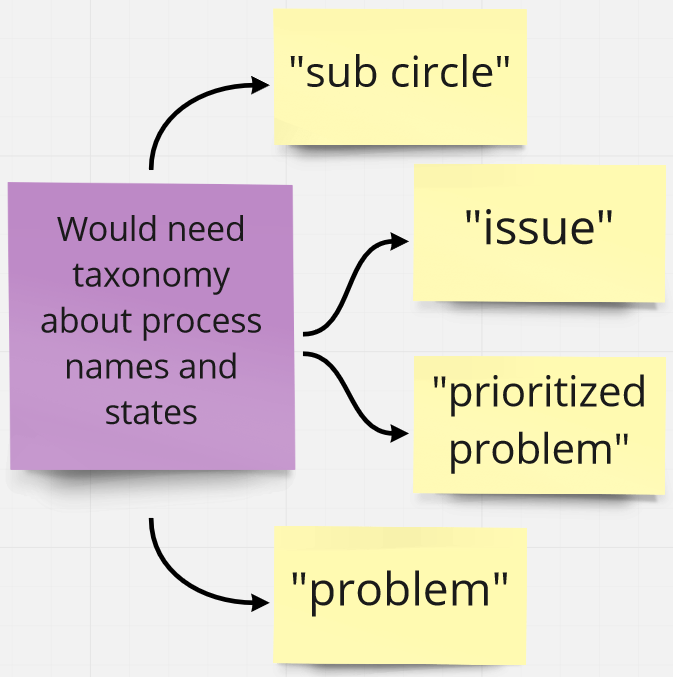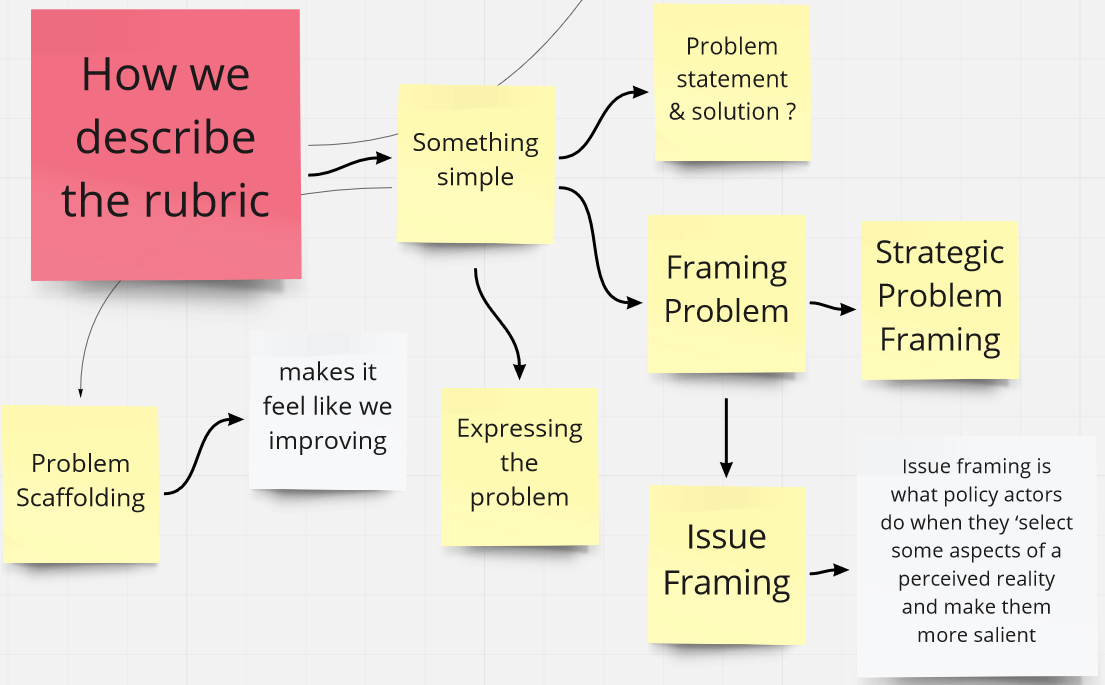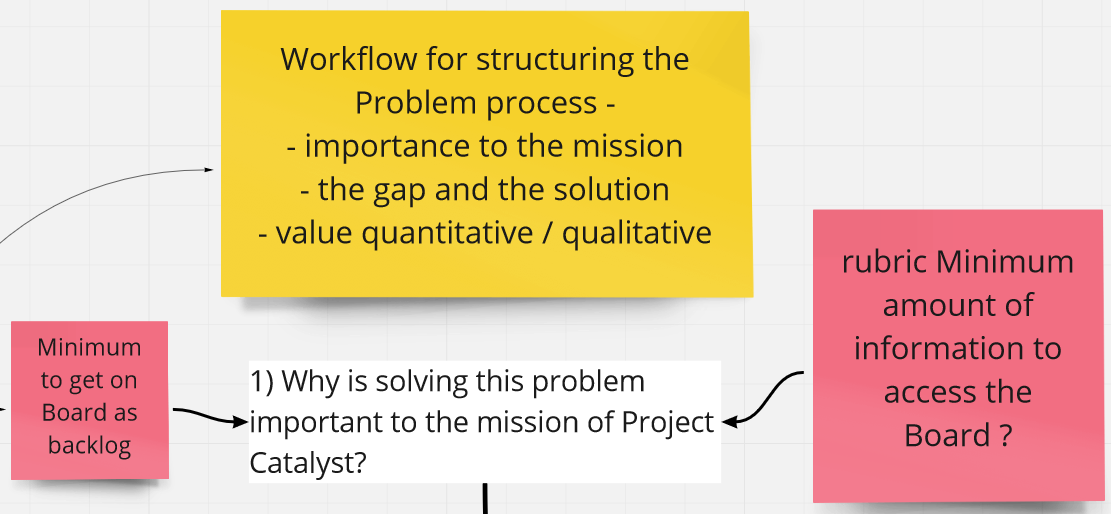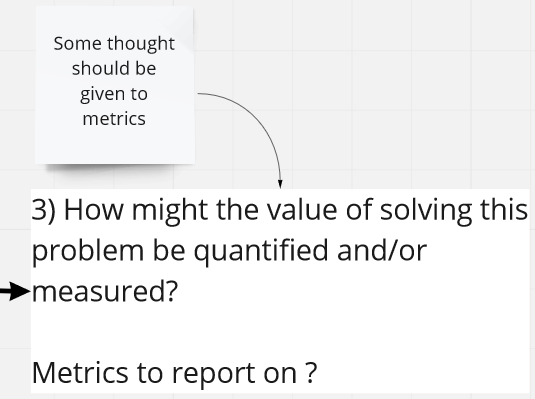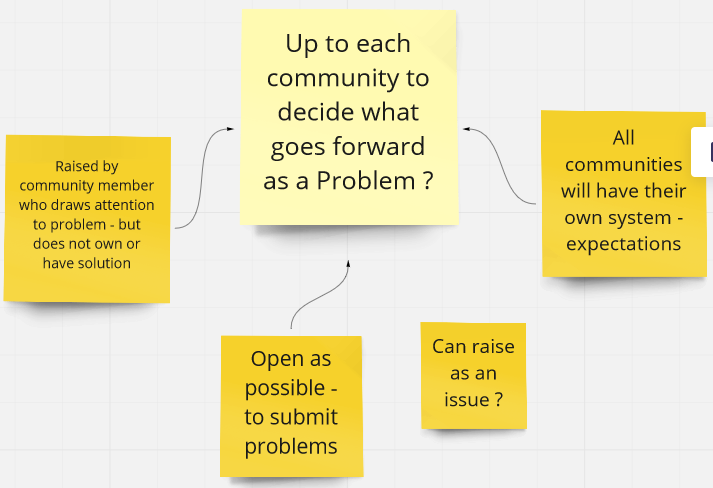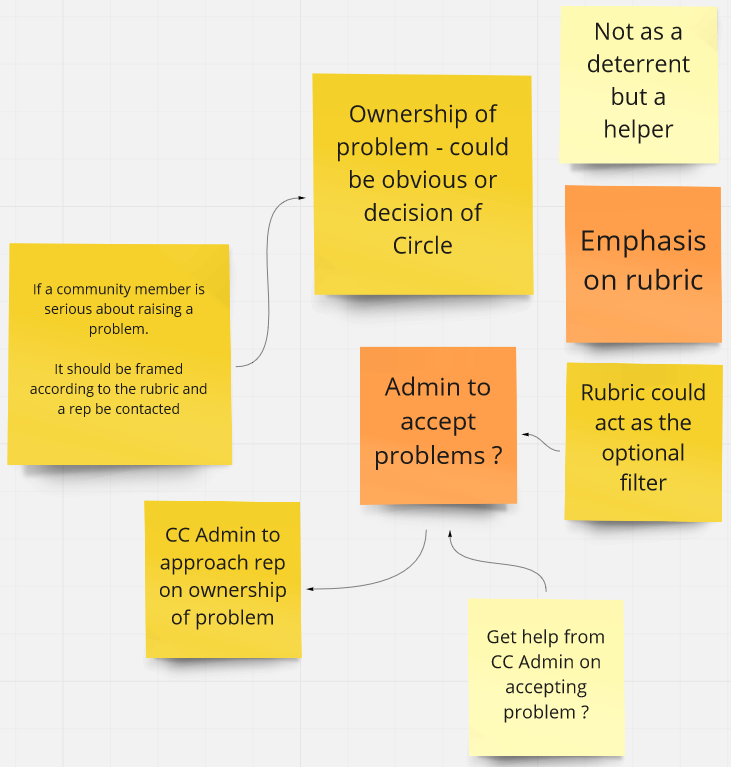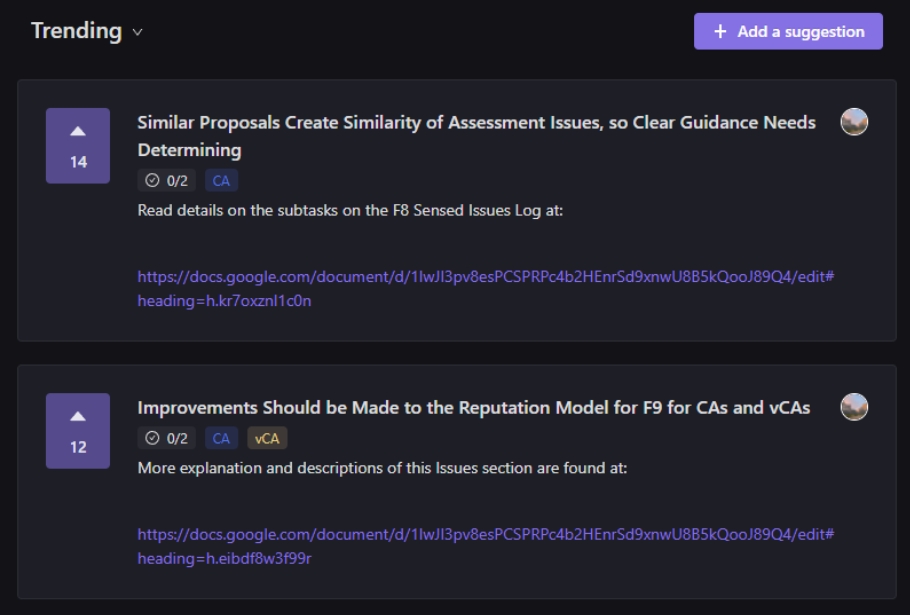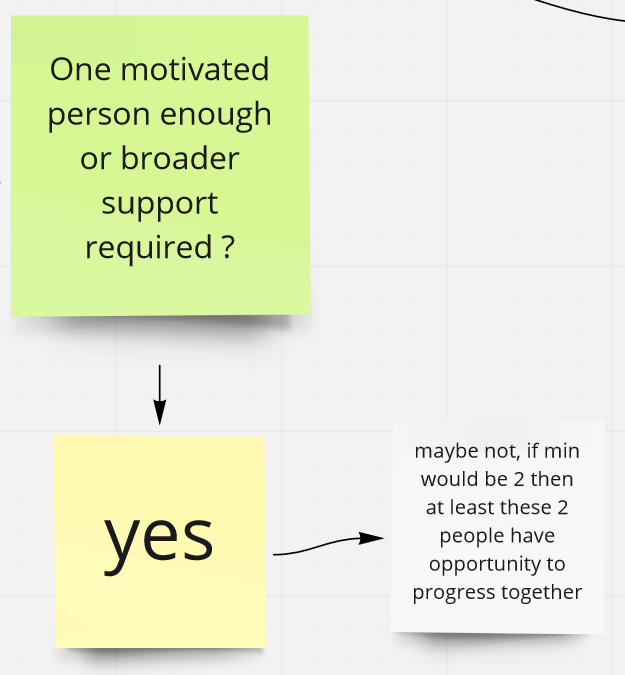Circle / Oversight Working group
Oversight of Catalyst Circle problem sensing - Working group
Miro Board - (link) - ideation
Working group meeting #1
Monday 11th April 2022
Nadia Hopkins - CCv3 Community Advisor Rep
Tevo Saks - CCv2 Toolmakers Rep
Stephen Whitenstall - CCv2 Funded Proposer Rep
Overview
This meeting sought to clarify the problem sensing process. It referred back to the original "Problem statement rubric" defined by GovernanceAlive in July 2021. This was then compared with Nadia Hopkin's CA/vCA Issues Log, Fund 8.
The Problem statement rubric
The Problem statement rubric was intended to clarify the Circle Problem Sensing process by providing criteria to assess a Prioritized Problem.
Identify
What problem do you see?
Problem Statement
Why is solving this problem important to the mission of Project Catalyst?
Solution articulation
Can you articulate the gap between the current state and the expected or envisioned state?
Metrics
How might the value of solving this problem be quantified and/or measured?
How the rubric aligns with Circle
After some discussion the working group identified the following workflow for categorization of solutions to Prioritized Problems
1) A Proposal or Challenge
Research questions and problem refinement
The Problem solution is either a Catalyst Proposal or Challenge Setting.
2) A specific decision.
Decision making body and coordination for problem
The Problem solution requires alignment on a specific decision. Stakeholders must be consulted on a parameter or process change.
Problem Ownership
The issue of Problem Ownership was discussed. Ownership is typically assigned naturally as a Circle Representative brings a Problem to Circle. But where there is ambiguity or the scope of the problem does not obviously align with a particular Circle Representative then someone must volunteer to steward the Problem.
Taximony
Clarity is needed on what specific terms mean. For example -
A sub-circle - is some kind of community organization that supports problem sensing for a Circle Representative.
A [Community] issue - is an issue posted to Circle but not raised as a Prioritized Problem.
A Prioritized Problem or Problem - is an issue that meets the Problem statement rubrik (above).
Working group meeting #2
Tuesday 19th April 2022, 1200 UTC
Nadia Hopkins - CCv3 Community Advisor Rep
Allison Fromm - CCv2 General ADA Holders Rep
Tevo Saks - CCv2 Toolmakers Rep
Stephen Whitenstall - CCv2 Funded Proposer Rep
Overview
This meeting built on the work of the previous meeting. We looked at how to describe the problem sensing rubric in accessible language and how to design a workflow for raising and reviewing a problem at a Circle meeting. Nadia Hopkins updated the group on how she had used the rubric while raising CA Prioritized Problems.
Problem Sensing
Is the Problem Sensing rubric discussed previously sufficient as a minimum to move forward ?
How do we describe the rubric ?
Discussion about how to describe the problem sensing rubric in simple language led to categorizations such as -
Problem scaffolding, Problem expression and framing a Problem
Prioritized Problem Process
How does the Problem Sensing rubric structure the Prioritized Problem Process ?
The group's first approach to the Prioritized Problem Process addressed entry onto the Problems Board and review of new Problems by Circle.
Ideation of a workflow for structuring this stage of the Problem process focused on the rubric expressed concisely as -
1) importance to Catalyst mission
2) the gap and the solution
3) value quantitative / qualitative (metrics)
The question of what minimum part of the rubric should be required to be put on the Problem Board backlog.
Is it sufficient for a Problem to just address the importance to the Catalyst mission of it's resolution ?
The conclusion was that 1) importance to the Catalyst mission & 2) some articulation of the gap between the current state and an expected solution be the minimum required to be placed in the Problem backlog.
The value of solving the problem
Quantitative / qualitative (metrics)
Therefore the value of solving the problem comes after its placing in the backlog. Given that Circle has identified 1) importance to the Catalyst mission & 2) some articulation of the gap between the current state and an expected solution then 3) some quantitative and/or qualitative metrics should be applied before the problem progresses any further.
Working group meeting #3
Wednesday 4th May 2022, 1030 UTC
Nadia Hopkins - CCv3 Community Advisor Rep
Allison Fromm - CCv2 General ADA Holders Rep
Tevo Saks - CCv2 Toolmakers Rep
Stephen Whitenstall - CCv2 Funded Proposer Rep
Overview
This meeting built on the work of the previous meeting. We looked at to what extent a Problem requires community support and how this should be quantified.
Community Support
Is it up to each community to decide what goes forward as a Problem ?
All communities will have their own expectations of a system or process to follow.
A Problem may be raised by a community member who draws attention to it but does not own it or have a solution. In which case who in the community decides the necessary end state for the Problem ?
It should be as open as possible to submit Problems.
Can a Problem be raised initially as an Issue ? What is the distinction ?
If a community member is serious about raising a problem it should be framed according to the rubric and a rep be contacted.
Ownership of problem - could be obvious or decision of Circle.
There should be emphasis on the Problem Sensing Rubric but as a helper not a deterrent.
Circle Admin
CC Admin to accept problems ?
The Rubric could act as an optional filter prior. Assistance from CC Admin in applying Rubric ?
CC Admin to approach Circle Rep on ownership of Problem (raised outside sub circles).
How might the value of solving this problem be quantified and/or measured?
What Metrics to report on ?
Example of Metrics - in the case of the CA Sub Circle - Outputs for CA Issues - how people react / feedback. Dework upvoting system.
Metric 1 - Community support / priority for solving problem
A metric to measure community support of a Problem.
Apply a priority scale ? 1 to 5 ?
Should a measure of community support determine progression to "To Do" on the Circle Problem Board ?
Why - practical sensing of community support - is there enough investment to pursue the problem ?
Some measure of support must be identified - a number, names, a group etc.
Legitimacy requires evidence of community support ?
Is one motivated person enough to raise a Problem or is broader support required ?
Maybe a minimum of two people ?
Maybe not, if min would be 2 then at least these 2 people have opportunity to progress together
Working group meeting #4
Tuesday 10th May 2022, 1200 UTC
Nadia Hopkins - CCv3 Community Advisor Rep
Allison Fromm - CCv2 General ADA Holders Rep
Tevo Saks - CCv2 Toolmakers Rep
Stephen Whitenstall - CCv2 Funded Proposer Rep
Overview
Stephen - 00:00
Previously we discussed metrics and now we move to Prioritized Problems themselves.
Community support for Prioritized Problems
Should there be community backing for a problem to be on the agenda and on the board?
How open is that?
Can it be initially raised as an issue?
How does it become become a community problem?
Problem Ownership
Should the problem go through a Problem sensing rubric before it gets to a Rep ?
Should Circle Admin accept problems ?
Problem metrics & up-voting issues
Consensus on measuring levels of community support
Note : Metrics to report in respect of part 3 of the Problem rubric - "How might this problem be quantified and/or measured?"
Inputs for metrics
Tevo - 03:59
Effective metrics that were stated every meeting.
How people react & listen to feedback.
Having a 1 to 5 score.
How many community members assign themselves to a problem.
2 is something we always want if we want decentralisation. Because this makes possible asynchronous collaboration.
References
Circle Problem - Review and Revise the Prioritized-Problems Workflow
Oversight of Catalyst Circle problem sensing
Last updated
